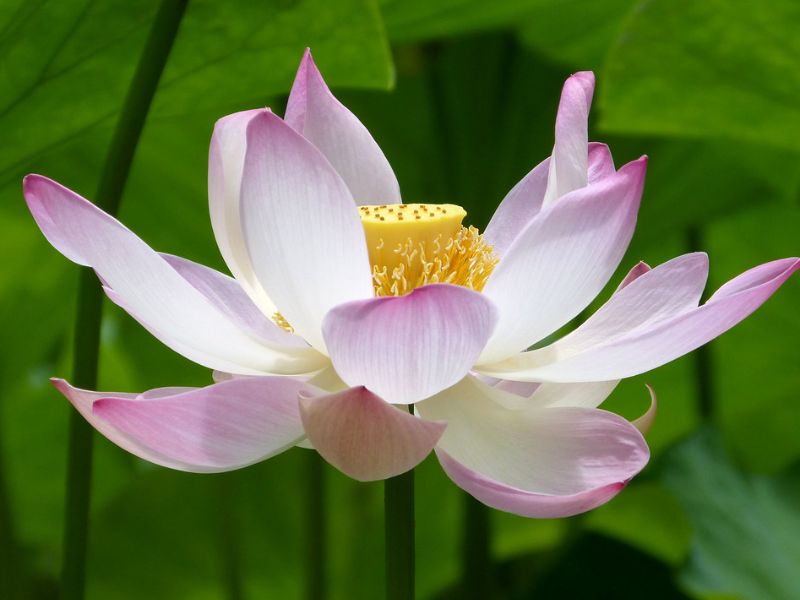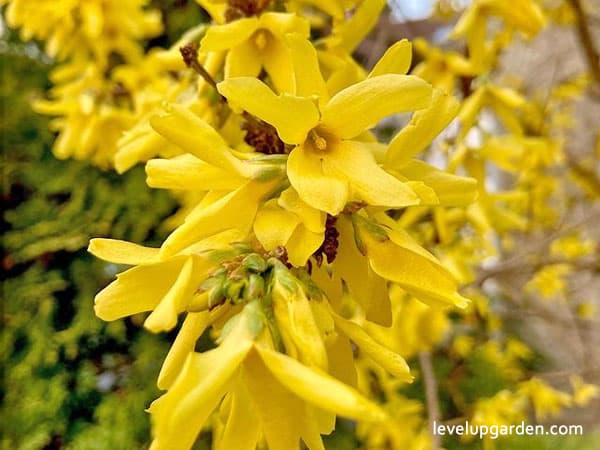The Wintergreen Boxwood, scientifically known as Buxus sinica var. Insularis ‘Wintergreen’, is a versatile and resilient addition to both formal and casual gardens.
With a penchant for shaping, this plant is perfect for crafting diminutive hedges or as a standalone beauty, especially when sculpted into eye-catching sphere or cone formations.
One of its best features is its exceptional cold tolerance, surviving temperatures plummeting to a frosty -10 degrees Fahrenheit.
But there’s more to this shrub than just its resilience. It’s compact, reaching a modest height of 2 to 4 feet and spreading between 3 to 5 feet.
This particular variety of Korean boxwood boasts foliage that remains a vibrant green throughout the chilliest winters. It’s the go-to choice for those looking for hedges, ornamental shapes, or even just a lush green presence in their garden. Although it does sport tiny fragrant flowers, they tend to be more visible on plants left to grow naturally.
It also has adaptability to varying lighting conditions and its heightened resistance to pests. Whether you place it in the sun or shade, the Wintergreen Boxwood, with a bit of care, will flourish and elevate your garden’s aesthetic.

I. Plant Profile – An Overview of the plant
- Common names: Wintergreen Boxwood, Korean Boxwood.
- Botanical names: Buxus sinica var. insularis ‘Wintergreen’.
- Mature size: Height: 2-4 feet; Width: 3-5 feet.
- Growth habit: Slow-growing; tends to form a toadstool mushroom shape if left untrimmed. Can be shaped into round, square, or oval forms.
- Bloom time: Spring
- Flower color: Inconsequential flowers (specific color not mentioned in the previous content).
- Soil: Adapts well to a variety of well-draining soils.
- Light: Full sun to partial shade.
- Water: Deep watering twice weekly when newly planted; once weekly during dry periods. Established plants are drought-tolerant.
- Fertilization: Balanced shrub fertilizer (e.g., 10-10-10) applied in spring; top dress with compost or manure once a year.
II. Appearance
The Wintergreen Boxwood, also commonly known as the Korean Boxwood, boasts an elegant and compact stature. With a mature size ranging between 2-4 feet in height and a width of 3-5 feet, it provides gardens with a neat, manicured appearance.
Its dense growth habit is characterized by hardy, green foliage that darkens as the plant ages, ensuring that the shrub remains vibrant and aesthetically pleasing year-round.
One of the best features of the Wintergreen Boxwood is its leaves. They are fairly small, delicate, and possess both a smooth look and feel. Unlike other boxwoods that may become yellow during the colder months, the Wintergreen retains its vivid green hue even in winter, ensuring consistency in its visual appeal.
When left to grow naturally, this boxwood tends to form into a unique toadstool or mushroom shape. However, its adaptable nature means it can also be expertly shaped into various forms, including round spheres, square cubes, or ovals.
Its slow-growing nature ensures that once it’s trimmed, it retains its shape for extended periods. Whether left untrimmed or meticulously shaped, the Wintergreen Boxwood serves as an alluring focal point in any landscape.

III. Growing and Care Conditions
Nurturing a Wintergreen Boxwood is a balance of sunlight, water, and regular upkeep. Though hardy, understanding its preferences can optimize its growth and ensure its vibrancy throughout the seasons.
Whether you’re a novice gardener or a seasoned horticulturist, familiarizing yourself with its specific care requirements will lead to a thriving and picturesque garden centerpiece. From its sunlight needs and watering schedule to its resilience against pests, we delve deeper into ensuring this boxwood remains a steadfast and verdant feature in your garden.
Planting
To plant a Wintergreen Boxwood, first select a location with full to partial sun exposure, where the plant will receive 4-8 hours of sunlight each day. In high-heat areas, some afternoon shade is beneficial. The soil should be well-draining.
Begin by digging a hole as deep as the root ball and twice its width. As you place the shrub into the hole, ensure it’s upright and straight. Gradually backfill, watering every couple of inches to avoid air pockets. Upon completion, mulch around the base extending 12 inches past the foliage, for moisture retention.
Planting in the spring or early summer allows the plant to acclimate before the cold sets in. The planting site should receive at least four hours of sun and have well-drained soil.
Prepare the hole with topsoil mixed with compost or manure, ensuring the top of the root ball is level with the ground. Fill in with your soil mixture, tamping to avoid air pockets. Upon completion, water deeply but avoid waterlogging, and mulch around the base, ensuring it doesn’t touch the trunk.
Watering
The key is deep watering, ensuring the roots get adequate moisture. While the plant is establishing, water every other day. As it matures, and you observe new growth, you can reduce this to a weekly routine. After the first year, the boxwood will generally only require additional water during drought conditions.
Fertilizer
At the onset of spring, before new growth, apply a balanced 10-10-10 shrub fertilizer. Additionally, annually enrich the soil with compost or manure, followed by a layer of mulch. This provides essential nutrients ensuring robust growth.
Pruning
While Wintergreens naturally grow into neat green tufts, they can be sculpted as desired. To ensure no damage to new growth, prune post the last frost of the season. If left untrimmed, they adopt a roughly round shape. If you detect dead or discolored branches, feel free to trim them off anytime.
Pests and Diseases
Boxwoods are susceptible to pests like boxwood leafminer, mite, and psyllid. Regular monitoring and cleaning the area around the bushes help manage these pests.
In case of diseases like root rot or canker, maintaining plant health is crucial. Boxwood blight, which causes defoliation, can be managed by pruning infected branches and ensuring overall plant health.
Pollination
Come spring, the Wintergreen boxwoods produce tiny flowers that release a delightful fragrance. This aroma attracts bees and other insects, facilitating pollination. The resulting fruit, however, is a small, non-edible seed capsule that often goes unnoticed.

IV. Maintenance
The Wintergreen Boxwood stands out as a low-maintenance plant, particularly due to its compact size, which means it doesn’t demand the frequent trimming that other boxwoods might. This attribute makes it an ideal choice for gardeners who seek elegance without investing too much time in upkeep.
- Trimming Frequency: One of the most appealing characteristics of the Wintergreen Boxwood is its flexibility in pruning. Those looking for a more organic look can limit their trimming sessions to once a year.
However, for garden enthusiasts who love a crisp, neat appearance, trimming the bush more often is beneficial. Clipping it multiple times a year, perhaps two or three, not only enhances its shape but also results in denser foliage, creating a lush green barrier or ornament in your garden.
- Spacing: When envisaging a dense hedge with your boxwoods, consider the spacing between each plant. For the densest outcome, placing them 12 inches apart is ideal. If you’re aiming for a slightly taller but equally packed hedge, then an 18-inch spacing is appropriate.
- Clipping Technique: The secret to a perennially thick and healthy hedge lies in the clipping technique. Always ensure the top of your hedge is slightly narrower than the base. This tapered approach ensures adequate sunlight reaches the lower sections, keeping the hedge robust from top to bottom.

V. Uses of Wintergreen Boxwood
The Wintergreen Boxwood is a versatile addition to any outdoor space, adding charm and elegance with minimal care requirements. Here’s a breakdown of its varied uses:
- Compact Yards: With the increasing trend towards smaller gardens, Wintergreen Boxwood becomes an ideal choice. Its compact size helps maximize limited space, transforming it into a visual delight.
- Hedges and Borders: For those aiming for a refined appearance, Wintergreen Boxwoods make impeccable hedges or low borders. Imagine lining your driveway or pathway with these, instantly adding sophistication to your home’s exterior.
- Backdrops for Perennials: Given its moderate height, the Wintergreen Boxwood can serve as a stunning backdrop for lower-growing perennials, letting those colorful blooms stand out even more.
- Decorative Accents: If you’re scouting for a statement plant to enhance the aesthetics of your terrace, patio, or entrance, this boxwood can be your go-to. Potted in an ornate container, it immediately elevates the space’s appeal.
- Beyond the Formal Garden: While boxwoods often evoke images of grandeur and meticulously maintained gardens, the Wintergreen variant can effortlessly blend into informal settings too. Let it grow naturally, without regular pruning, and watch it infuse life and greenery into your garden.
- Container Gardening: One of its undervalued attributes is its adaptability to container gardening. Owing to its modest growth pace, it’s an ideal patio plant. For those residing in colder regions, the container’s mobility is a boon, allowing you to shift the plant indoors during harsh winters.

VI. Why You Should Have a Wintergreen Boxwood for Your Garden
Gardens often benefit from simplicity. The inclusion of plain green plants, when clipped into neat, unassuming shapes, serves as a visual breather. They become the frame that transforms sporadic splashes of color into a coherent picture, the boundary that transforms flower beds into a garden.
Among these green artists, the Boxwood stands out with a storied history. It’s the go-to for creating those crisp borders, ornamental balls, cones, and even the wave-like formations found in Japanese gardens.
However, not all Boxwoods are built the same. Enter the Wintergreen Boxwood, also known as the Korean Boxwood. This cold-hardy variant is perfect for both casual and formal landscape designs.
Its adaptability extends beyond garden placements; Wintergreen looks equally resplendent in decorative pots, accentuating patios or decks.
What’s more, it demands minimal maintenance. Its growth rate is modest, at 2 to 3 inches annually, reaching a mature height of about 3 feet and spreading 3 to 5 feet. This ensures that, even with its evergreen, dense foliage, it doesn’t dominate a space but complements it.
Wintergreen’s aesthetic isn’t just about its shape. The color deserves a mention too. Unlike other Boxwoods that fade in winter, Wintergreen retains a vibrant green, enhancing its appeal during colder months. Although adaptable to various light conditions, a bit of shade should be good. Soil variety isn’t an issue either.
In terms of form, while the Wintergreen naturally adopts a toadstool mushroom shape, it’s often formed into spheres, cubes, or ovals. Its slow growth ensures that once shaped, it retains its form for an extended period.
In essence, the Wintergreen Boxwood isn’t merely a plant—it’s an investment in your garden’s aesthetic. Whether you’re a gardening newbie or a seasoned green thumb, this shrub promises beauty with ease.
How often should I water my Wintergreen Boxwood?
Initially, after planting, you should water your Wintergreen Boxwood every other day. Once new growth appears, reduce watering to once a week. After the first year, the shrub typically doesn’t need supplemental watering unless in drought conditions.
Can I plant the Wintergreen Boxwood in a container?
Absolutely! The Wintergreen Boxwood is well-suited for container planting due to its compact size and slow growth rate. It can be a great addition to patios or decks when placed in decorative pots.
How does the Wintergreen Boxwood handle cold temperatures?
The Wintergreen Boxwood is notably cold-hardy. Unlike some other boxwoods that may lose color or become yellowish during the cold months, the Wintergreen retains its vibrant green throughout the winter.
Do I need to prune my Wintergreen Boxwood regularly?
While the Wintergreen Boxwood doesn’t require frequent pruning to thrive, you can shape it to your preference. If left untrimmed, it adopts a natural toadstool mushroom shape. However, many gardeners opt to shape it into spheres, cubes, or ovals. It retains its shape for a long time due to its slow growth.








Leave a Reply